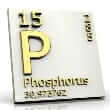Background
- Phosphorus is a mineral found in many foods, such as milk, cheese, grains, dried beans, peas, colas, nuts, and peanut butter. Phosphate is the most common form of phosphorus. In the body, phosphate is the most abundant intracellular anion. It is critical for energy storage and metabolism, the utilization of many B-complex vitamins, the buffering of body fluids, kidney excretion of hydrogen ions, proper muscle and nerve function, and maintaining calcium balance. Phosphorus is vital to the formation of bones and teeth, and healthy bones and soft tissues require calcium and phosphorus to grow and develop throughout life. Inadequate intake of dietary phosphate can lead to hypophosphatemia (low levels of phosphate in the blood), which can lead to long-term potentially serious complications. Conversely, excess phosphate intake can lead to hyperphosphatemia (high blood phosphorus levels), which occurs particularly in people with impaired kidney function and can lead to potentially serious electrolyte imbalances, adverse effects, or death.
- In adults, phosphorus makes up approximately 1% of total body weight. It is present in every cell of the body, although 85% of the body's phosphorus is found in the bones and teeth.
- Phosphates are used clinically to treat hypophosphatemia and hypercalcemia (high blood calcium levels), as saline laxatives, and in the management of calcium-based kidney stones. They may also be of some benefit to patients with vitamin D-resistant rickets, multiple sclerosis, and diabetic ketoacidosis (a very serious complication in which the body only uses fatty acids as fuel and produces acidic ketone bodies).
- Based on the potential for side effects associated with high blood levels of phosphorus, phosphorus supplementation should be done only under medical supervision.
References
- Bredle DL, Stager JM, Brechue WF, et al. Phosphate supplementation, cardiovascular function, and exercise performance in humans. J Appl Physiol 1988;65(4):1821-1826.
View Abstract - Bugg NC, Jones JA. Hypophosphataemia. Pathophysiology, effects and management on the intensive care unit. Anaesthesia 1998;53(9):895-902.
View Abstract - Ehrenpreis ED, Nogueras JJ, Botoman VA, et al. Serum electrolyte abnormalities secondary to Fleet's Phospho-Soda colonoscopy prep. A review of three cases. Surg Endosc 1996;10(10):1022-1024.
View Abstract - Fakiris AJ, Moore DH, Reddy SR, et al. Intraperitoneal radioactive phosphorus (32P) and vaginal brachytherapy as adjuvant treatment for uterine papillary serous carcinoma and clear cell carcinoma: a phase II Hoosier Oncology Group (HOG 97-01) study. Gynecol Oncol 2005;96(3):818-823.
View Abstract - Fine A, Patterson J. Severe hyperphosphatemia following phosphate administration for bowel preparation in patients with renal failure: two cases and a review of the literature. Am J Kidney Dis. 1997;29(1):103-105.
View Abstract - Finn WF, Joy MS. A long-term, open-label extension study on the safety of treatment with lanthanum carbonate, a new phosphate binder, in patients receiving hemodialysis. Curr Med Res Opin. 2005;21(5):657-664.
View Abstract - Fisher JN, Kitabchi AE. A randomized study of phosphate therapy in the treatment of diabetic ketoacidosis. J.Clin.Endocrinol.Metab 1983;57(1):177-180.
View Abstract - Garg JP, Chasan-Taber S, Blair A, et al. Effects of sevelamer and calcium-based phosphate binders on uric acid concentrations in patients undergoing hemodialysis: a randomized clinical trial. Arthritis Rheum 2005;52(1):290-295.
View Abstract - Heaney RP, Nordin BE. Calcium effects on phosphorus absorption: implications for the prevention and co-therapy of osteoporosis. J Am Coll Nutr 2002;21(3):239-244.
View Abstract - Helikson MA, Parham WA, Tobias JD. Hypocalcemia and hyperphosphatemia after phosphate enema use in a child. J Pediatr Surg 1997;32(8):1244-1246.
View Abstract - Kastenberg D, Chasen R, Choudhary C, et al. Efficacy and safety of sodium phosphate tablets compared with PEG solution in colon cleansing: two identically designed, randomized, controlled, parallel group, multicenter phase III trials. Gastrointest Endosc 2001;54(6):705-713.
View Abstract - Kemi VE, Kärkkäinen MU, Lamberg-Allardt CJ. High phosphorus intakes acutely and negatively affect Ca and bone metabolism in a dose-dependent manner in healthy young females. Br J Nutr. 2006 Sep;96(3):545-52.
View Abstract - Kuschel CA, Harding JE. Calcium and phosphorus supplementation of human milk for preterm infants. Cochrane Database Syst Rev. 2001;(4):CD003310.
View Abstract - Kurihara S, Tsuruta Y, Akizawa T. Effect of MCI-196 (colestilan) as a phosphate binder on hyperphosphataemia in aemodialysis patients: a double-blind, placebo-controlled, short-term trial. Nephrol Dial Transplant 2005;20(2):424-430.
View Abstract - National Research Council, Food and Nutrition Board. Recommended Dietary Allowances. 10th ed. Washington, D.C.: National Academy Press; 1989:184-187.







